Peugeot Expert VU 2016 Owner's Manual - RHD (UK, Australia)
Manufacturer: PEUGEOT, Model Year: 2016, Model line: Expert VU, Model: Peugeot Expert VU 2016Pages: 520, PDF Size: 11.2 MB
Page 251 of 520
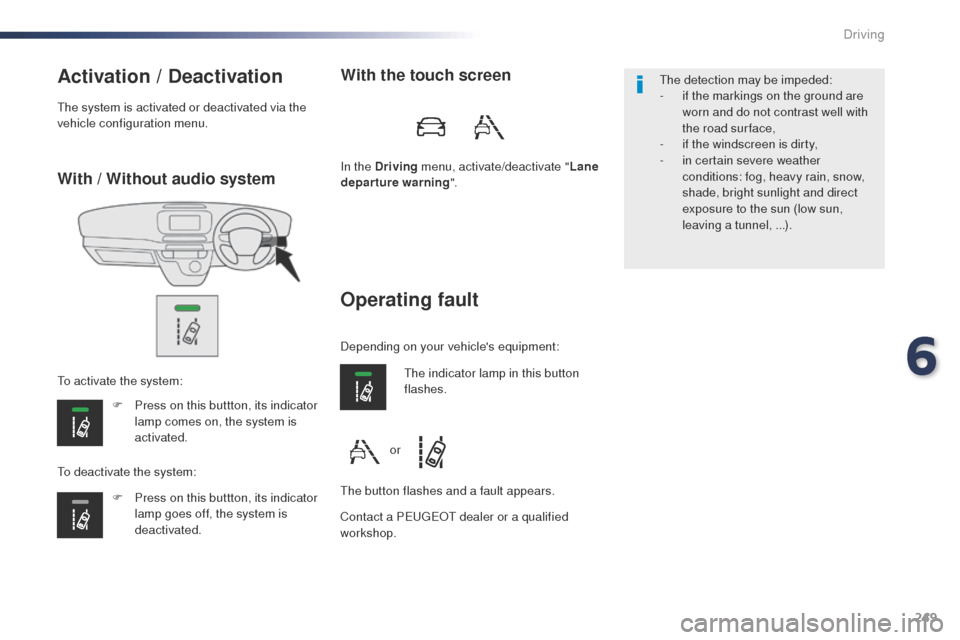
249
With / Without audio system
Activation / Deactivation
F Press on this buttton, its indicator lamp comes on, the system is
activated.
F
P
ress on this buttton, its indicator
lamp goes off, the system is
deactivated.
to a
ctivate the system:
to d
eactivate the system:
th
e system is activated or deactivated via the
vehicle configuration menu.
Operating fault
With the touch screen
In the Driving menu, activate/deactivate " Lane
departure warning ".
Contact a P
e
ugeot dealer or a qualified
workshop.
th
e indicator lamp in this button
flashes.
th
e button flashes and a fault appears.
Depending on your vehicle's equipment:
th
e detection may be impeded:
-
i
f the markings on the ground are
worn and do not contrast well with
the road sur face,
-
i
f the windscreen is dirty,
- i n certain severe weather
conditions: fog, heavy rain, snow,
shade, bright sunlight and direct
exposure to the sun (low sun,
leaving a tunnel, ...).
or
6
Driving
Page 252 of 520
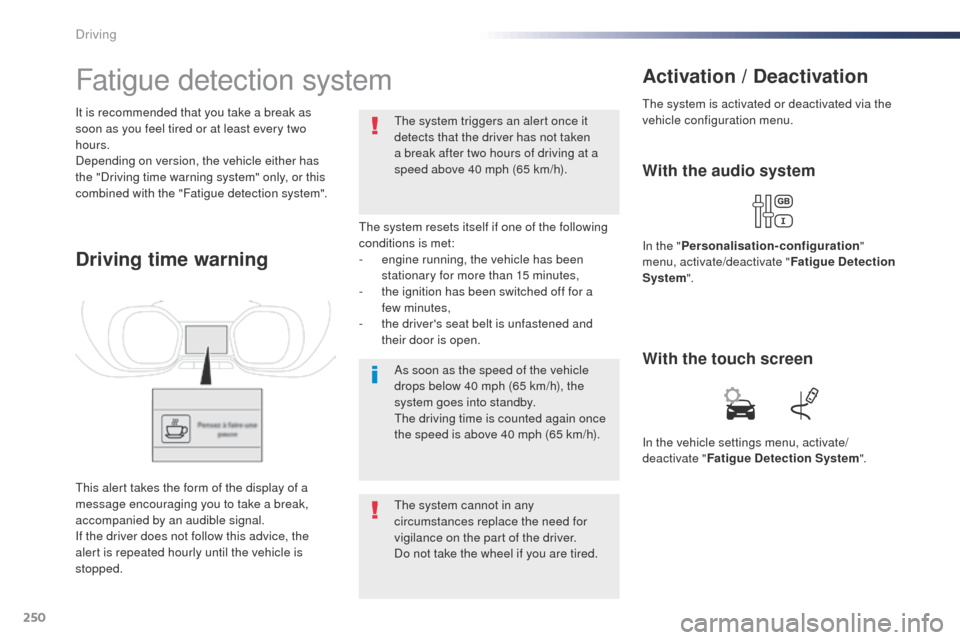
250
Fatigue detection system
the system resets itself if one of the following
conditions is met:
-
e
ngine running, the vehicle has been
stationary for more than 15 minutes,
-
t
he ignition has been switched off for a
few
minutes,
-
t
he driver's seat belt is unfastened and
their door is open.
As soon as the speed of the vehicle
drops below 40 mph (65 km/h), the
system goes into standby.
th
e driving time is counted again once
the speed is above 40 mph (65 km/h).
th
e system cannot in any
circumstances replace the need for
vigilance on the part of the driver.
Do not take the wheel if you are tired.
th
e system triggers an alert once it
detects that the driver has not taken
a break after two hours of driving at a
speed above 40 mph (65 km/h).
It is recommended that you take a break as
soon as you feel tired or at least every two
hours.
Depending on version, the vehicle either has
the "Driving time warning system" only, or this
combined with the "Fatigue detection system".
Driving time warning
With the audio system
In the "
Personalisation-configuration "
menu, activate/deactivate " Fatigue Detection
System ".
Activation / Deactivation
the system is activated or deactivated via the
vehicle configuration menu.
th
is alert takes the form of the display of a
message encouraging you to take a break,
accompanied by an audible signal.
If the driver does not follow this advice, the
alert is repeated hourly until the vehicle is
stopped. In the vehicle settings menu, activate/
deactivate "
Fatigue Detection System ".
With the touch screen
Driving
Page 253 of 520
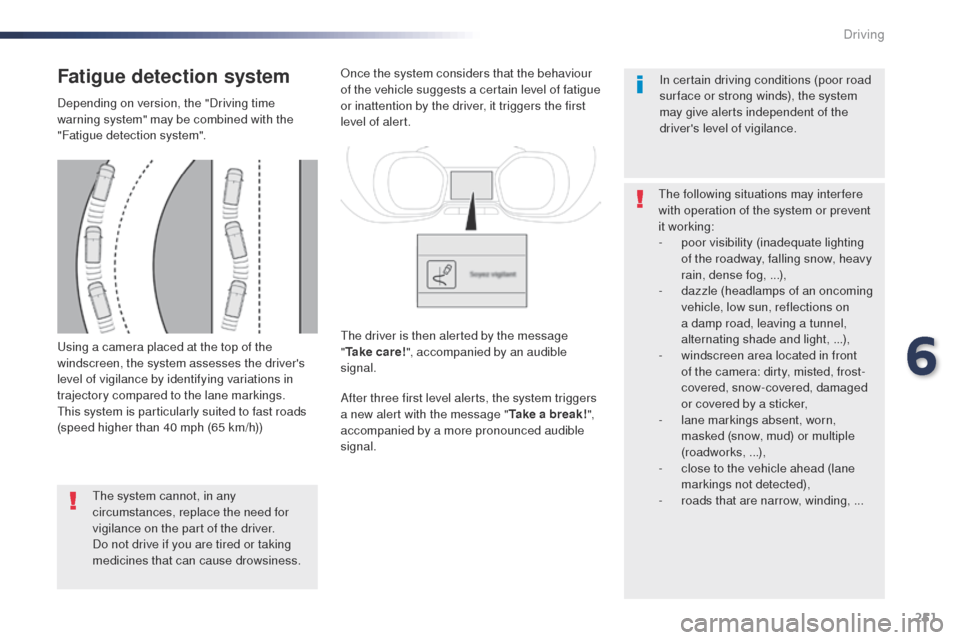
251
using a camera placed at the top of the
windscreen, the system assesses the driver's
level of vigilance by identifying variations in
trajectory compared to the lane markings.
th
is system is particularly suited to fast roads
(speed higher than 40 mph (65 km/h))
Fatigue detection system
Depending on version, the "Driving time
warning system" may be combined with the
"Fatigue detection system".
th
e system cannot, in any
circumstances, replace the need for
vigilance on the part of the driver.
Do not drive if you are tired or taking
medicines that can cause drowsiness.
on
ce the system considers that the behaviour
of the vehicle suggests a certain level of fatigue
or inattention by the driver, it triggers the first
level of alert.
After three first level alerts, the system triggers
a new alert with the message " Take a break!",
accompanied by a more pronounced audible
signal. In certain driving conditions (poor road
sur face or strong winds), the system
may give alerts independent of the
driver's level of vigilance.
th
e following situations may inter fere
with operation of the system or prevent
it working:
-
p
oor visibility (inadequate lighting
of the roadway, falling snow, heavy
rain, dense fog, ...),
-
d
azzle (headlamps of an oncoming
vehicle, low sun, reflections on
a damp road, leaving a tunnel,
alternating shade and light, ...),
-
w
indscreen area located in front
of the camera: dirty, misted, frost-
covered, snow-covered, damaged
or covered by a sticker,
-
l
ane markings absent, worn,
masked (snow, mud) or multiple
(roadworks, ...),
-
c
lose to the vehicle ahead (lane
markings not detected),
-
r
oads that are narrow, winding, ...
th
e driver is then alerted by the message
" Ta k e c a r e ! ", accompanied by an audible
signal.
6
Driving
Page 254 of 520
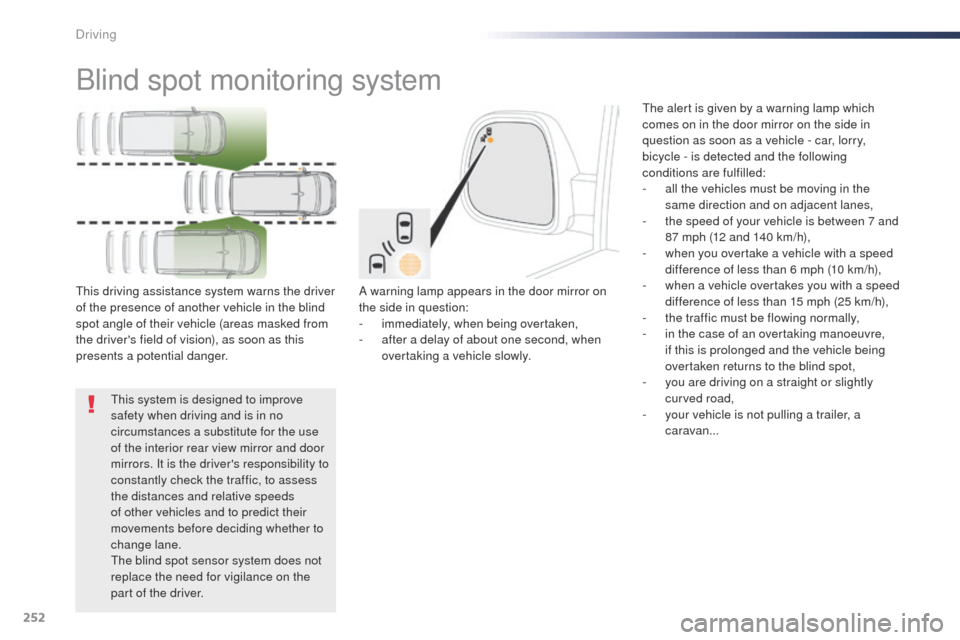
252
Blind spot monitoring system
A warning lamp appears in the door mirror on
the side in question:
-
i
mmediately, when being overtaken,
-
a
fter a delay of about one second, when
overtaking a vehicle slowly.th
is driving assistance system warns the driver
of the presence of another vehicle in the blind
spot angle of their vehicle (areas masked from
the driver's field of vision), as soon as this
presents a potential danger.
th
e alert is given by a warning lamp which
comes on in the door mirror on the side in
question as soon as a vehicle - car, lorry,
bicycle - is detected and the following
conditions are fulfilled:
-
a
ll the vehicles must be moving in the
same direction and on adjacent lanes,
-
t
he speed of your vehicle is between 7 and
87 mph (12 and 140 km/h),
-
w
hen you overtake a vehicle with a speed
difference of less than 6 mph (10 km/h),
- w hen a vehicle overtakes you with a speed
difference of less than 15 mph (25 km/h),
-
t
he traffic must be flowing normally,
-
i
n the case of an overtaking manoeuvre,
if this is prolonged and the vehicle being
overtaken returns to the blind spot,
-
y
ou are driving on a straight or slightly
curved road,
-
y
our vehicle is not pulling a trailer, a
caravan...
th
is system is designed to improve
safety when driving and is in no
circumstances a substitute for the use
of the interior rear view mirror and door
mirrors. It is the driver's responsibility to
constantly check the traffic, to assess
the distances and relative speeds
of other vehicles and to predict their
movements before deciding whether to
change lane.
th
e blind spot sensor system does not
replace the need for vigilance on the
part of the driver.
Driving
Page 255 of 520
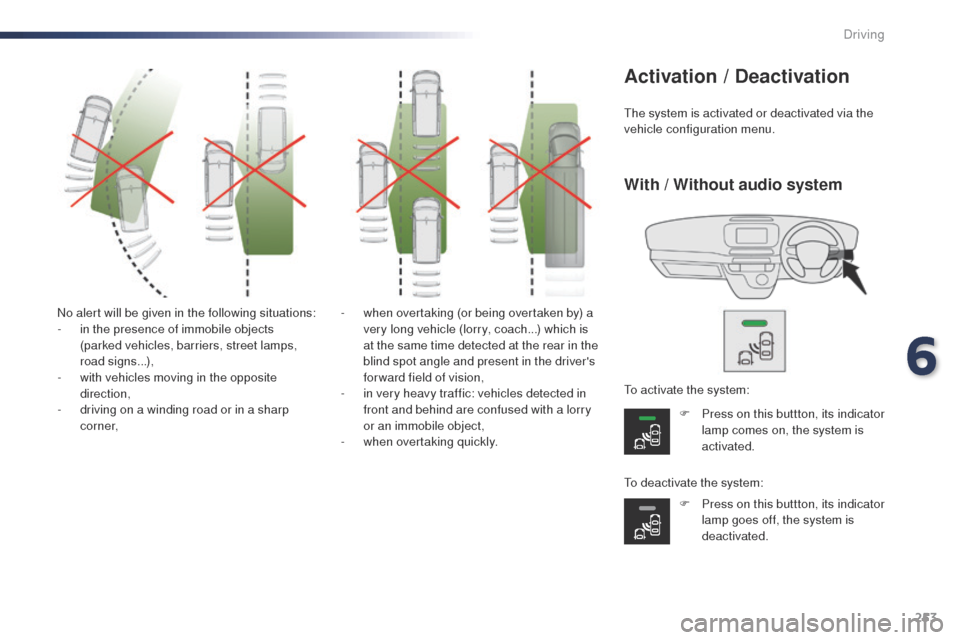
253
No alert will be given in the following situations:
- i n the presence of immobile objects
(parked vehicles, barriers, street lamps,
road signs...),
-
w
ith vehicles moving in the opposite
direction,
-
d
riving on a winding road or in a sharp
c o r n e r, -
w hen overtaking (or being overtaken by) a
very long vehicle (lorry, coach...) which is
at the same time detected at the rear in the
blind spot angle and present in the driver's
forward field of vision,
-
i
n very heavy traffic: vehicles detected in
front and behind are confused with a lorry
or an immobile object,
-
w
hen overtaking quickly.
th
e system is activated or deactivated via the
vehicle configuration menu.
Activation / Deactivation
F Press on this buttton, its indicator lamp comes on, the system is
activated.
F
P
ress on this buttton, its indicator
lamp goes off, the system is
deactivated.
to a
ctivate the system:
to d
eactivate the system:
With / Without audio system
6
Driving
Page 256 of 520
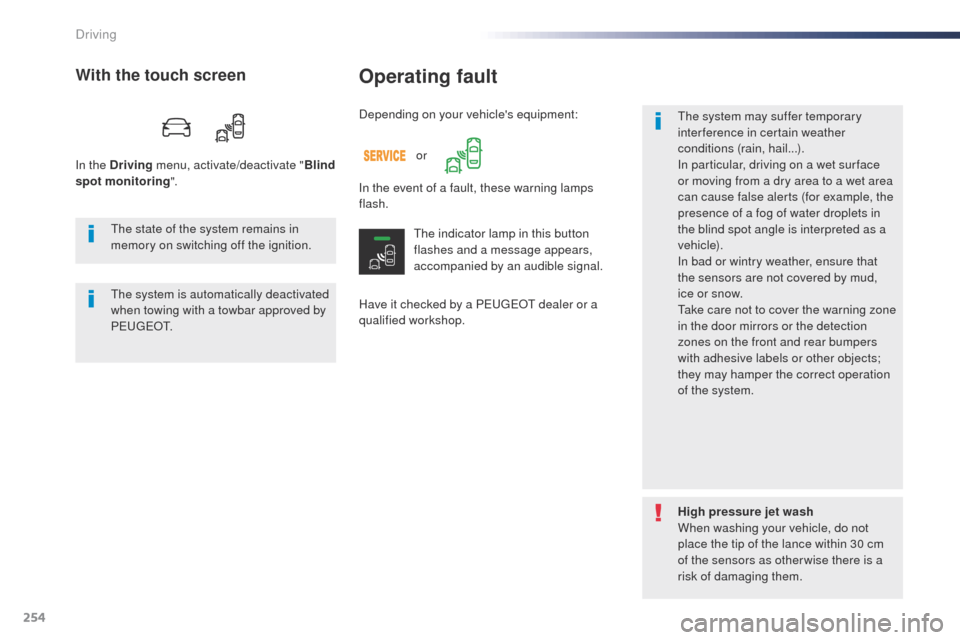
254
Operating fault
Have it checked by a Peugeot dealer or a
qualified workshop.
th
e system may suffer temporary
interference in certain weather
conditions (rain, hail...).
In particular, driving on a wet sur face
or moving from a dry area to a wet area
can cause false alerts (for example, the
presence of a fog of water droplets in
the blind spot angle is interpreted as a
vehicle).
In bad or wintry weather, ensure that
the sensors are not covered by mud,
ice or snow.ta ke care not to cover the warning zone
in the door mirrors or the detection
zones on the front and rear bumpers
with adhesive labels or other objects;
they may hamper the correct operation
of the system.
Depending on your vehicle's equipment:
With the touch screen
In the Driving
menu, activate/deactivate " Blind
spot monitoring ".
In the event of a fault, these warning lamps
flash.
th
e indicator lamp in this button
flashes and a message appears,
accompanied by an audible signal.
th
e state of the system remains in
memory on switching off the ignition.
th
e system is automatically deactivated
when towing with a towbar approved by
P
e
u g e o t .
High pressure jet wash
When washing your vehicle, do not
place the tip of the lance within 30 cm
of the sensors as otherwise there is a
risk of damaging them.
or
Driving
Page 257 of 520
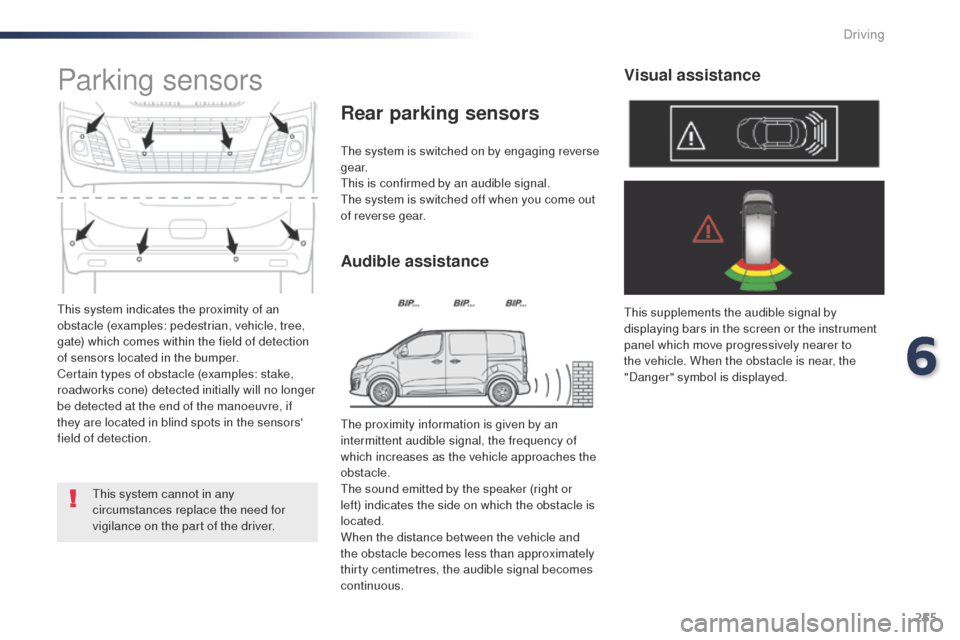
255
this system indicates the proximity of an
obstacle (examples: pedestrian, vehicle, tree,
gate) which comes within the field of detection
of sensors located in the bumper.
Certain types of obstacle (examples: stake,
roadworks cone) detected initially will no longer
be detected at the end of the manoeuvre, if
they are located in blind spots in the sensors'
field of detection.
Parking sensors
the system is switched on by engaging reverse
g e a r.
th
is is confirmed by an audible signal.
th
e system is switched off when you come out
of reverse gear.
Audible assistance
Rear parking sensors
this supplements the audible signal by
displaying bars in the screen or the instrument
panel which move progressively nearer to
the vehicle. When the obstacle is near, the
"Danger" symbol is displayed.
Visual assistance
this system cannot in any
circumstances replace the need for
vigilance on the part of the driver.
th
e proximity information is given by an
intermittent audible signal, the frequency of
which increases as the vehicle approaches the
obstacle.th e sound emitted by the speaker (right or
left) indicates the side on which the obstacle is
located.
When the distance between the vehicle and
the obstacle becomes less than approximately
thirty centimetres, the audible signal becomes
continuous.
6
Driving
Page 258 of 520
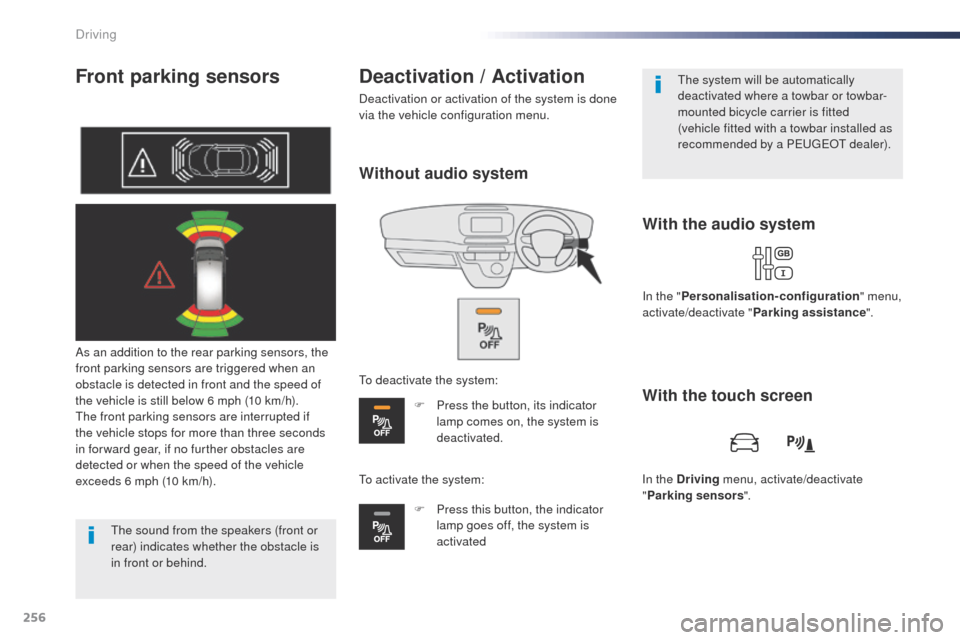
256
Front parking sensors
As an addition to the rear parking sensors, the
front parking sensors are triggered when an
obstacle is detected in front and the speed of
the vehicle is still below 6 mph (10 km/h).
th
e front parking sensors are interrupted if
the vehicle stops for more than three seconds
in for ward gear, if no further obstacles are
detected or when the speed of the vehicle
exceeds 6 mph (10 km/h).
With the audio system
Deactivation / Activation
Deactivation or activation of the system is done
via the vehicle configuration menu.
th
e sound from the speakers (front or
rear) indicates whether the obstacle is
in front or behind.
th
e system will be automatically
deactivated where a towbar or towbar-
mounted bicycle carrier is fitted
(vehicle fitted with a towbar installed as
recommended by a P
e
ugeot dealer).
In the " Personalisation-configuration " menu,
activate/deactivate " Parking assistance ".
With the touch screen
In the Driving menu, activate/deactivate
" Parking sensors ".
Without audio system
to deactivate the system:
F
P
ress the button, its indicator
lamp comes on, the system is
deactivated.
to a
ctivate the system: F
P
ress this button, the indicator
lamp goes off, the system is
activated
Driving
Page 259 of 520
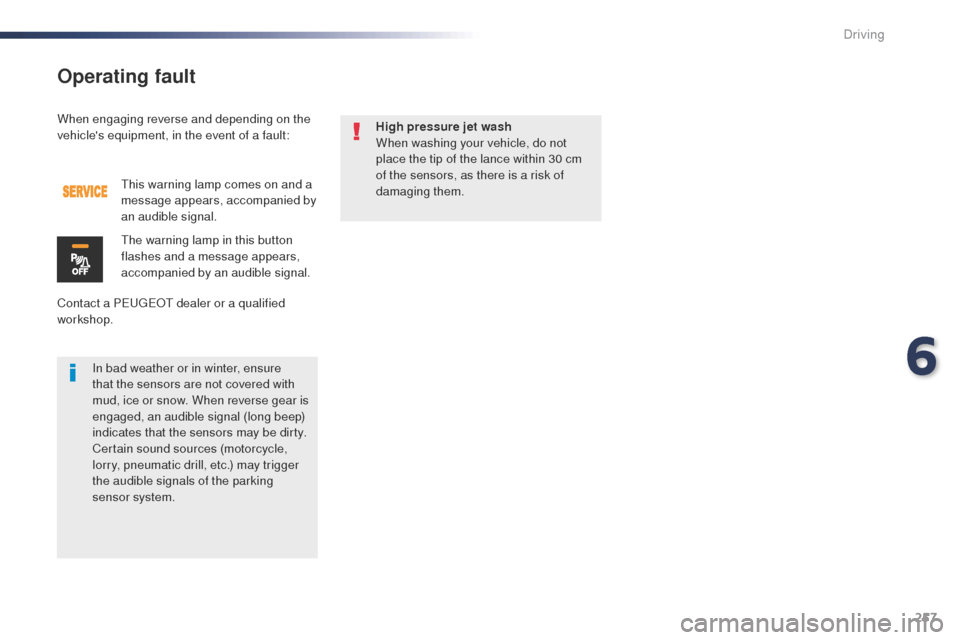
257
When engaging reverse and depending on the
vehicle's equipment, in the event of a fault:
Contact a P
e
ugeot dealer or a qualified
workshop.
th
is warning lamp comes on and a
message appears, accompanied by
an audible signal.
th
e warning lamp in this button
flashes and a message appears,
accompanied by an audible signal.
In bad weather or in winter, ensure
that the sensors are not covered with
mud, ice or snow. When reverse gear is
engaged, an audible signal (long beep)
indicates that the sensors may be dirty.
Certain sound sources (motorcycle,
lorry, pneumatic drill, etc.) may trigger
the audible signals of the parking
sensor system. High pressure jet wash
When washing your vehicle, do not
place the tip of the lance within 30 cm
of the sensors, as there is a risk of
damaging them.
Operating fault
6
Driving
Page 260 of 520
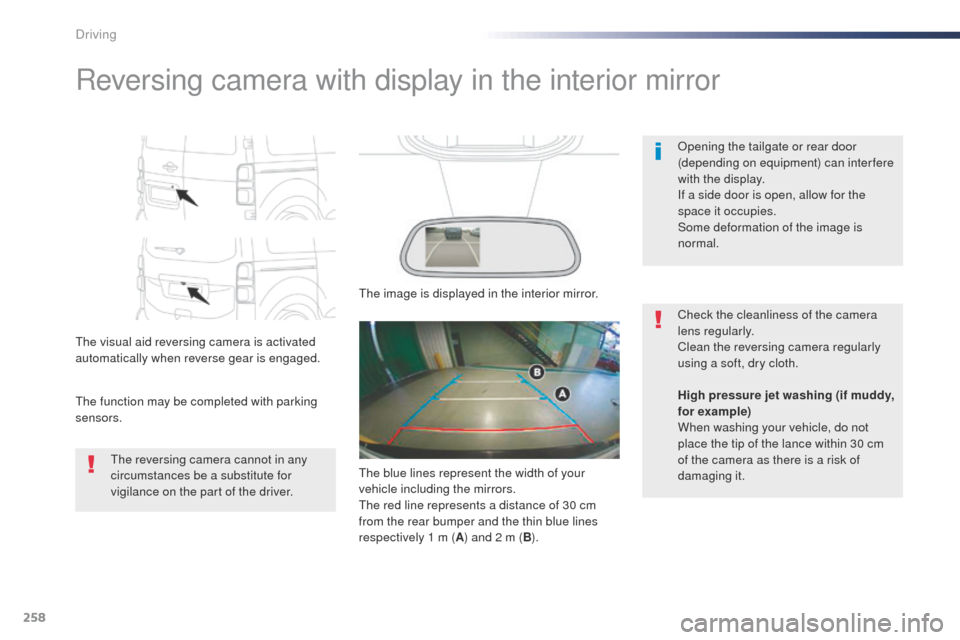
258
Reversing camera with display in the interior mirror
the visual aid reversing camera is activated
automatically when reverse gear is engaged.
th
e function may be completed with parking
sensors.
op
ening the tailgate or rear door
(depending on equipment) can interfere
with the display.
If a side door is open, allow for the
space it occupies.
Some deformation of the image is
normal.
th
e reversing camera cannot in any
circumstances be a substitute for
vigilance on the part of the driver. Check the cleanliness of the camera
lens regularly.
Clean the reversing camera regularly
using a soft, dry cloth.
th
e image is displayed in the interior mirror.
High pressure jet washing (if muddy,
for example)
When washing your vehicle, do not
place the tip of the lance within 30
cm
of the camera as there is a risk of
damaging it.
th
e blue lines represent the width of your
vehicle including the mirrors.
th
e red line represents a distance of 30 cm
from the rear bumper and the thin blue lines
respectively 1 m ( A) and 2 m ( B).
Driving